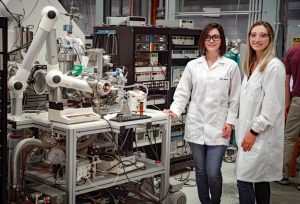Study Confirms Sun Exposure Increases Oxygen Molecules in Oil Slicks
– JANUARY 16, 2020
Scientists compared laboratory-generated weathered oil with weathered oil samples collected during Deepwater Horizon to better understand how different processes, specifically photo-oxidation and bio-oxidation, affect how oil changes chemically and physically. The analyses showed that the oxygen-containing oil molecules from field samples were nearly identical to those generated in a simulated solar microcosm. However, there was no match to weathered oil molecules generated in a bio-oxidation microcosm. These results imply that photo-oxidation and not bio-oxidation facilitated the formation of oil-soluble oxygenated transformation products found in field samples of weathered Deepwater Horizon oil, which could have hindered physical and chemical remediation efforts. An improved understanding of the processes that generate oil-soluble oxidation products may inform future clean-up efforts, such as identifying a time period when dispersant application in sunlit waters would be most effective.
The researchers published their findings in Environmental Science & Technology: Molecular-level characterization of oil-soluble ketone/aldehyde photo-oxidation products by Fourier Transform Ion Cyclotron Resonance Mass Spectrometry reveals similarity between microcosm and field samples.
When oil floats on the sea surface, its physical properties (viscosity, density, boiling point) and chemical properties (molecular composition) change as it encounters wind, waves, evaporation, sun irradiation, and bacteria. Increases in the oil’s oxygen atoms change the oil’s viscosity to a thick mousse-like mixture that hinders skimming efforts (increased weight and volume of material) and the effectiveness of chemical dispersants (transformed oil residues are only partially soluble by dispersant systems).
“Previous studies have suggested that both bio-oxidation and photo-oxidation contribute to oil-soluble species in weathered oils,” said study author Ryan Rodgers. This study sought to clarify the roles of these weathering processes in forming oil-soluble oxygenated species, clarification which is not discernable from environmental samples.
Using ultrahigh-resolution Fourier-transform ion cyclotron resonance mass spectrometry (FT-ICR MS) at the National High Magnetic Field Laboratory, the team selectively isolated, derivatized, and analyzed oil-soluble aldehydes and ketones from laboratory-generated weathered oil samples. They incubated Macondo oil in a Solar Simulation Microcosm (48 hours irradiation = 12 days of natural sunlight) and in a Biodegradation Microcosm (for 30 days) and compared the molecular compositions of oil spill field samples and microcosm samples. The field samples of oil came from an offshore floating oil mat near Pensacola, FL (June 2010); a sand patty in Gulf Shores, AL (November 2011); and a rock scraping on Dauphin Island, AL (January 2014). The microbial populations were from Gulf of Mexico seawater.
“The present results, along with other recent manuscripts (Ruddy et al., May 2014; Ward et al., January 2018, and Ward et al., April 2018) strongly suggest that photo-oxidation is the dominant mechanism for the formation of oil-soluble transformation products from native (un-weathered) petroleum molecules and that these products are unique to the photo-oxidation process,” explained Rodgers. “Furthermore, if the composition of these aldehyde / ketone species is time dependent, knowledge of their temporal evolution as a function of solar irradiation could provide valuable information on the residence time of future field samples. This could provide a photo-oxidation “fingerprint” of the solar irradiation history of field samples, giving a measure of how long an oil slick has been at the sea surface (when the spill occurred).”
Data are publicly available through the Gulf of Mexico Research Initiative Information & Data Cooperative (GRIIDC) at DOI 10.7266/n7-jdr0- dz24, DOI 10.7266/n7-mpw7-rx40, and DOI 10.7266/n7-3d8b-0860.
The study’s authors are Sydney F. Niles, Martha L. Chacon-Patin, Huan Chen, Amy M. McKenna, Greg T. Blakney, Ryan P. Rodgers, and Alan G. Marshall.
By Nilde Maggie Dannreuther. Contact maggied@ngi.msstate.edu with questions or comments.
************
This research was made possible in part by a grant from the Gulf of Mexico Research Initiative (GoMRI) to Florida State University and the University of New Orleans for the project Molecular Understanding of Emulsion Formation in Environmentally Photo-Oxidized Crude Oils: In Situ Generation of Interfacially Active Species and Their Impact on Emulsification. Additional support was provided by the National Science Foundation Cooperative Agreement (No. DMR-1644779), the Florida State University Future Fuels Institute, and the State of Florida.
The Gulf of Mexico Research Initiative (GoMRI) is a 10-year independent research program established to study the effect, and the potential associated impact, of hydrocarbon releases on the environment and public health, as well as to develop improved spill mitigation, oil detection, characterization and remediation technologies. An independent and academic 20-member Research Board makes the funding and research direction decisions to ensure the intellectual quality, effectiveness and academic independence of the GoMRI research. All research data, findings and publications will be made publicly available. The program was established through a $500 million financial commitment from BP. For more information, visit https://gulfresearchinitiative.org/.
© Copyright 2010-2019 Gulf of Mexico Research Initiative (GoMRI) – All Rights Reserved. Redistribution is encouraged with acknowledgement to the Gulf of Mexico Research Initiative (GoMRI). Please credit images and/or videos as done in each article. Questions? Contact web-content editor Nilde “Maggie” Dannreuther, Northern Gulf Institute, Mississippi State University (maggied@ngi.msstate.edu).






